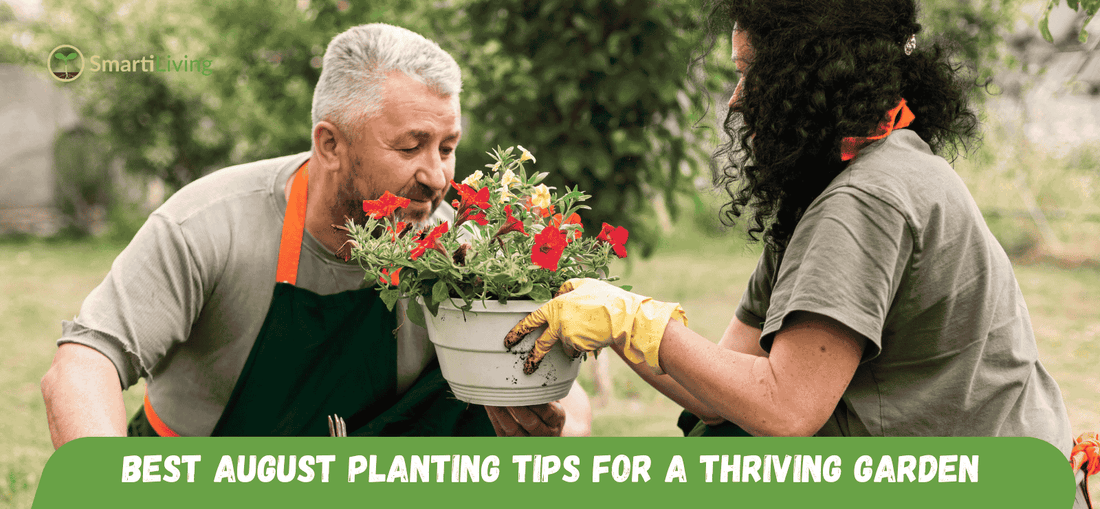
August Planting Guide: Use Self Watering for a Thriving Fall Garden
Share
August's warm soil and cooler nights create the perfect environment for planting your fall garden. But the summer heat demands smart watering strategies. This guide covers the best plants for August and how self watering systems can be your secret weapon for success, ensuring your plants thrive while conserving water.
What to Plant in August for a Fall Harvest
1. Vegetables for Fall Harvest
- Leafy Greens: Spinach, kale, lettuce, and arugula. Their quick growth is ideal for cooler days.
- Root Vegetables: Carrots, beets, and radishes develop a sweeter taste in the fall.
- Brassicas: Broccoli, cabbage, and Brussels sprouts need a long, cool season to flourish.
- Fast-Growing Crops: Bush beans and peas can still produce a bounty before the first frost.
2. Herbs to Sow Now
- Cilantro, dill, and parsley thrive in the changing temperatures.
- Plant perennial herbs like thyme and sage to establish strong roots before winter.
3. Flowers for Late-Season Color
- Pansies & Violas: Tough enough to withstand light frosts.
- Mums & Asters: The classic stars of the autumn garden.
- Wildflowers: Sow seeds now for a spectacular spring display.
Essential August Gardening Tips
✔ Conserve Water with Smart Irrigation
Deep, consistent moisture is critical for germination and growth in August heat. Self watering systems like terracotta watering spikes deliver water directly to the roots, reducing evaporation and ensuring your new plantings never dry out.
✔ Mulch Heavily to Retain Moisture
A layer of straw or wood chips keeps the soil cool and locks in the moisture provided by your self watering system, meaning you refill reservoirs less often.
✔ Watch for Pests
Aphids and squash bugs are still active. Use neem oil or row covers for protection.
✔ Start Fall Transplants Indoors
Begin seedlings for kale, broccoli, and cabbage indoors to transplant into the garden in September.
How Self Watering Systems Make August Planting Easier
August planting faces one major hurdle: intense heat that quickly dries out soil. This is where a self watering system becomes essential.
-
Promotes Germination: Seeds and seedlings need consistently moist soil to sprout and establish roots. Self watering spikes provide this perfectly.
-
Saves Time & Water: Instead of daily hand-watering, a self watering system maintains optimal moisture levels, preventing waste through evaporation and runoff.
-
Ideal for Containers: Potted herbs and greens dry out fastest. A self watering spike ensures they survive the August sun.
Regional August Planting Guide
| Region | Best August Plants | Watering Tip |
|---|---|---|
| Northern Zones | Spinach, radishes, mums | Use self watering spikes to extend time between watering as nights cool. |
| Southern Zones | Okra, sweet potatoes, collards | Self watering is crucial to combat extreme heat and sun. |
| Coastal Areas | Lettuce, cilantro, beets | Even with humidity, self watering provides consistent moisture. |
Final Thoughts
August is a prime month to extend your gardening season. By choosing the right crops and employing efficient self watering techniques, you can ensure your garden remains productive and beautiful through the fall.
Set your August plantings up for success with SmartiLiving’s terracotta watering spikes the effortless self watering solution for a bountiful harvest.
FAQ: August Planting & Self Watering
Q: Can I use self watering systems for seed beds?
A: Yes, but use them carefully. Place the spike near the bed and allow the water to seep through the soil to avoid disturbing the seeds. A DIY wicking system can also work well for seedlings.
Q: How often should I refill my self watering spikes in August?
A: In the peak August heat, check reservoirs every 2-3 days. Larger bottles will last longer. Combining spikes with mulch significantly reduces water consumption.
Q: What’s the best mulch to use with a self watering system?
A: Straw or shredded leaves are excellent. They keep the soil cool and prevent the water in your self watering system from evaporating too quickly.
